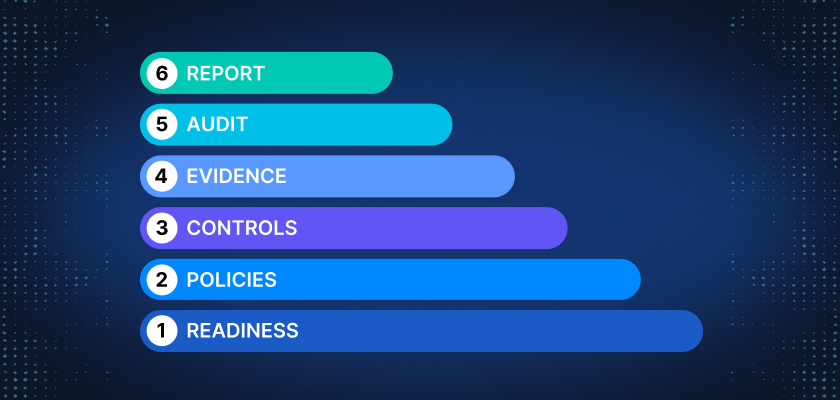
For managed service providers and security-focused organizations, SOC 2 compliance isn’t a “nice to have,” it’s foundational.
Whether you’re supporting regulated industries, managing sensitive client data, or simply trying to close deals faster, SOC 2 demonstrates that your security practices are built on trust, transparency, and operational maturity.
This guide walks you through the full SOC 2 journey, from readiness assessments and control design to audit, reporting, and ongoing compliance.
What Does It Mean to Be SOC 2 Compliant?
SOC 2 compliance means your organization has implemented and documented controls that align with the AICPA’s Trust Services Criteria, including:
- Security (required)
- Availability
- Processing Integrity
- Confidentiality
- Privacy
SOC 2 isn’t a certification, it’s a third-party attestation. An independent auditor verifies whether your policies, systems, and practices meet these standards, and documents the results in a formal SOC 2 report.
Why SOC 2 Compliance Is a Competitive Advantage
Achieving SOC 2 signals to clients and partners that you take data protection seriously. It creates tangible business value:
- Builds Trust – Shows that your security posture is mature, verified, and auditable
- Accelerates Sales Cycles – Reduces back-and-forth in vendor reviews and security questionnaires
- Supports Enterprise Deals – Meets the requirements of larger clients and regulated industries
- Reduces Churn Risk – Gives existing clients confidence in your long-term compliance and security practices
Your SOC 2 Compliance Roadmap
Follow these steps to reach, and maintain, SOC 2 compliance:
- Readiness Assessment
Evaluate which Trust Services Criteria apply. Review your current environment to identify policy gaps, control weaknesses, and documentation needs. - Control Design and Documentation
Draft the necessary policies and procedures. Assign ownership and timelines for implementing controls like onboarding, access review, and incident response. - System Scoping
Define which systems, tools, vendors, and environments are included in the audit. Document any subservice organizations and their impact on your controls. - Control Implementation
Put the controls into action, technical (e.g., MFA, logging, encryption) and procedural (e.g., HR checklists, vendor reviews, change management). - Evidence Collection and Testing
Collect documentation, logs, screenshots, and artifacts that demonstrate your controls are in place. Conduct internal testing or a mock audit if needed. - Formal SOC 2 Audit (Type I or II)
Engage a licensed CPA or audit firm to conduct the SOC 2 assessment.- Type I validates control design.
- Type II validates both design and operational effectiveness over a 3–12 month period.
- Type I validates control design.
- Post-Audit Remediation and Maintenance
Address any findings or control gaps. Set up a process for continuous monitoring and ensure your controls are maintained ahead of annual renewals.
SOC 2 Pitfalls and How to Avoid Them
Avoid these common challenges during your compliance journey:
- Lack of Documentation
Even well-implemented controls can fail an audit if they aren’t formally documented. - Undefined Control Ownership
Assign specific responsibilities for each control, ambiguity leads to missed deadlines and audit delays. - Shadow IT and Visibility Gaps
Untracked tools or infrastructure can expose risk and create audit friction. - Unprepared Teams
Team members should understand and follow documented processes, they may be interviewed by auditors. - Manual Evidence Collection
Gathering logs and documentation from scattered systems wastes time and increases the risk of inconsistency. Automation is key.
Frequently Asked Questions About SOC 2 Compliance
It varies by maturity level. On average:
- Type I: 2–3 months (after readiness work)
- Type II: 6–12 months (includes observation period)
A readiness assessment is a prep phase to identify and fix issues before engaging an auditor. The formal audit is conducted by an independent CPA and results in a SOC 2 report.
Yes, with the right platform and internal collaboration, MSPs and smaller teams can reach compliance using structured automation and clear ownership.
Ongoing monitoring of controls, annual policy reviews, updated evidence collection, and preparing for re-audits every 12 months (for Type II reports).